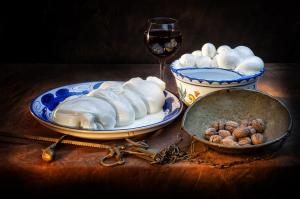Is my life with or without a filter? It depends, I would say.
I love the sieves. Do you know those big flour sieves? Or those little colored plastic ones with which the children play on the beach? Here I am. I could say to be an honorary fellow of the sieves. Although I love organic flour, in fact, I love the action of scouring the white one (“0”) and also powdered sugar, when I bake my cakes. In the preparation of these ciambelline, for example, I sifted ricotta, flour and potato starch, and then the icing sugar. The white clouds that I produced made me smile (yes, even here I speak of slowness and smiles), because the slow settling of the white powder on the work surface in the kitchen makes me happy.
In the garden, then, the activity that I love the most, is raking, which is basically another filtering operation. Before the eyes of the memories, the strong mountain peasants view of my childhood, with huge rakes collecting the freshly cut grass, which went from pannier to pannier to the stables for the winter. They used to comb the fields, spreading in the air the balsamic aroma of fresh hay, long before some smart entrepreneur turned this into a great business, with hay baths, which are good, expecially for those people allergic to pollen.
I’m not avoiding the subject that I’ve chosen for this post, basically, I’m just talking about filters. At 50 years old reached today (I’m 50, now!), did I learn the art of diplomacy, in which the use of filters is essential? Not really. And here’s the thing. If one of my goals for growth is to cause as little damage as possible, I have to learn to use those filters , porca vacca! (oops! Here I’m slipping again). More and more often I hear that the older you get, the more you become intolerant. Therefore, it would seem that the use of filters is inversely proportional to age, usually. I have to look at the matter from a different point of view, then.
Did you think I would give definitive answers? Hmm, I haven’t learned yet, you will not find them in this blog. I can tell you though that reversing the thing a little, I note that filters can both let the best part of the matter go through, or keep it to let the waste go. Did you ever think about it in these terms?
The gold diggers scour water or sand seeking the nugget and translators, like them, select from a text the most suitable meaning (speaks beautifully at the end of this article, Alessandro Iovinelli). There is another example much more pleasure-seeking,a filter that retains the best part and lets the waste go: you see it in this picture, where the the unusually shaped container on which are placed the mozzarella is actually a “scolamozzarelle”, while the bowl below collects the milk that comes from the buffalo pearls.
Nothing solved, at the end. I therefore continue to wonder what now I’m asking you, who have read this far: if we ever learn to be diplomatic, would we have learned to keep the best or the worst part? Will we apply, then, the art of diplomacy? Well, for now I’ll go eat a mozzarella, since it’s almost lunch time.


